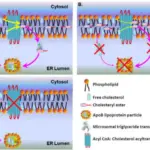Malabsorption is difficulty in the digestion or absorption of nutrients from food. Malabsorption can affect growth and development, or it can lead to specific illnesses.
What is the Pathology of Malabsorption?
The pathology of malabsorption is:
-Etiology: The cause of malabsorption is damage to the intestine from infection, inflammation, trauma, or surgery. prolonged use of antibiotics.
-Genes involved: None.
-Pathogenesis: The sequence of events that lead to malabsorption are physiological digestion and absorption of nutrients within the gastrointestinal tract requires a complex interaction between motor, secretory, digestive, and absorptive functions that is vulnerable to a multitude of potential disturbances which may lead to global or specific malabsorption syndromes.
-Histology: The histology associated with malabsorption shows autoantibodies for islet and parietal cells.
How does Malabsorption Present?
Patients with malabsorption typically men present at older ages. The symptoms, features, and clinical findings associated with malabsorption include: bloating and stomach distention, diarrhea, fatigue, gas, steatorrhea, or stool that is pale to white, stools that appear “greasy” in texture, stomach cramping, weakness.
How is Malabsorption Diagnosed?
Malabsorption is diagnosed by a stool test, complete blood cell count, and iron tests.
How is Malabsorption Treated?
Malabsorption is treated with vitamin supplements, enzyme supplements, and diet changes.
What is the Prognosis of Malabsorption?
The prognosis of malabsorption is good. Malabsorption may be temporary. Complications are directly related to the type of nutrient not being absorbed. In some cases, people get persistent diarrhea, weight loss, and abdominal pain.



